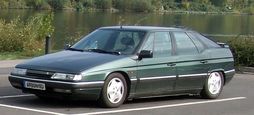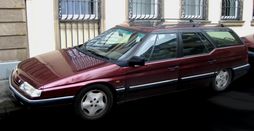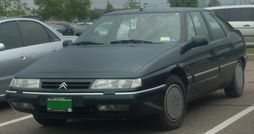The History Of Citroen XM

The Citroën XM is an executive car that was produced by the French automaker Citroën between 1989 and 2000. Citroën sold 330,000 XMs during the model's 10 years of production. The XM was voted 1990 European Car of the Year.
Launched in 1989, the XM was the modern iteration of the Big Citroën, a replacement for the Citroën CX.
The XM won the prestigious European Car of the Year award in 1990 and went on to win a further 14 awards that year.
The extreme, slender, and well-proportioned Bertone design, which took Gandini's Citroën BX concept to its natural conclusion. Its looks drew heavily on the Citroën SM of the 1970s, sharing similar lines and looks, tailored to meet higher production numbers and lower production cost.
There were many advances, most apparently designed to counteract concerns about the vintage CX design. The CX leaned in corners, so the XM had active electronic management of the suspension; the CX rusted, so the XM had a part-galvanised bodyshell (most surviving XMs have very little corrosion); the CX was underpowered, so the XM offered the option of a 3.0L V6 engine – the first in a Citroën since the Maserati-engined SM of 1970.
The XM shared a floorpan with the Peugeot 605 - the two models fared similarly in both teething problems and market acceptance. Unlike the CX and the 605 sedans, the XM was a liftback design - a feature thought to be desirable in certain European markets.
The XM inherited a loyal global customer base of executive class customers and a clear brand image, but did not enjoy the commercial success and iconic status of its predecessors, the CX and the DS, which both raised the bar of automotive performance for other manufacturers.
Export markets experienced lower sales from the outset, and home market sales also declined, after the mechanical issues of the first few model years became known. The least expensive XM was nearly 50% more expensive at the time of launch than the corresponding CX. In spite of that, it sold well during the first two years. Unfortunately it suffered from defective electrical connectors, due to excessive economies on the components, since the parent company was in financial difficulty at the time of the design of the XM.
With total sales over its lifetime of just 330,000 units and no immediate replacement, the XM might be considered a failure, particularly in markets such as the United Kingdom, where demand was reduced to a virtual trickle by the late 1990s. But despite its common roots with the Peugeot 605, the XM may still emerge as a collectible car, as the DS and CX both did.
The hydropneumatic self-leveling suspension (featuring grapefruit-sized metal spheres containing nitrogen, acting as both springs and shock absorbers) gained a very sophisticated electronic control system called Hydractive, which used sensors in the steering, brakes, suspension, throttle pedal and transmission to feed information on the car's speed, acceleration, and road conditions to on-board computers. Where appropriate - and within milliseconds - these computers switched an extra suspension sphere in or out of circuit, to allow the car a smooth supple ride in normal circumstances, or greater roll resistance for better handling in corners.
The Hydractive system was somewhat "ahead of the curve" when the car was launched and early versions were sometimes unreliable. Many problems stemmed from the sensitive electronics controlling the car's hydraulic system, often caused by the poor quality of the multipoint grounding blocks — one on each front inner wing, one at the rear, and one under the dashboard. These tended to corrode (especially the ones in the engine compartment), causing all manner of intermittent faults which were hard to diagnose. On later cars, these were changed to screw terminals bolted through the bodywork, and most of the older cars have been modified in a similar way.
When the Hydractive system worked, the result was a big car with a smooth "magic carpet" ride, and better handling than many smaller, lighter, sports cars. When it didn't work, it was quite harsh and bumpy, although no worse than any contemporary high-performance sports sedan. However, right-hand drive XMs were never fitted with the DIRAVI variable fully powered steering of the CX, having an almost conventional DIRASS power-assisted setup.
Some production models of the XM were not equipped with the Hydractive system, but had a 'conventional' hydropneumatic suspension closer to that of the Citroën BX. These lower specification vehicles were all built for markets in mainland Europe.
The XM was fitted with a wide range of gasoline and diesel engines.
Being part of the PSA Peugeot-Citroën company, most of these engines were found in contemporary PSA cars, like the Citroën Xantia, Citroën C5, Peugeot 405, Peugeot 406 and Peugeot 605. The ZF 4HP18 automatic transmission - the late V6 had 4HP20 - was used also in Saab 9000, Peugeot 605, Alfa Romeo 164, Lancia Thema and the Fiat Croma.
- Length: 4,709mm (185.4in) (Berline) or 4,950mm (194.9in) (Break) or 4,963mm (195.4in) (1998 V6 Break)
- Width: 1,793mm (70.6in)
- Height: 1,392mm (54.8in) (most Berline models); some turbo models 1,385mm (54.5in); 1,466mm (57.7in) (1998 V6 Break)
- Wheelbase: 2,850mm (112.2in)
- Ground clearance: 140mm (5.5in)
- Weight: 1,310kg (2,888lb) (2.0i Berline) - 1,400kg (3,086lb) (2.0 Turbo Berline) - 1,453kg (3,203lb) (Turbo Break) - 1,475kg (3,252lb) (1990 V6) - 1,642kg (3,620lb) (Turbo 2.5D Break) - 1,655kg (3,649lb) (1998 V6 Break)
- Fuel tank capacity: 80L (21US gal; 18impgal)
There are a number of visible differences between the first generation (1989-1994) and second generation (1995 onwards) cars. The most distinctive external differences are that in second generation XMs, the Citroën double-chevron logo was moved back to the centre of the front grille and was larger, rather than the offset position in the first generation cars; the 'XM' badge on the rear had a more stylised font; and mirrors and bumpers on second generation cars were color-coded on all models of second generation cars rather than the black plastic on lower-specification first generation vehicles. Other differences were internal; the instrument panel was modernized and the second generation introduced a conventional steering wheel including an integrated airbag. The second generation model never saw Citroën’s distinctive single-spoke wheel, which was replaced by a two-spoke wheel partway through first generation production. The second generation cars were also fitted with a lower rear spoiler on the tailgate, sitting much closer to the lip of the lid.
The standard 5-door models were called 'Berline'. The XM was also available as a ‘Break’ (station wagon) – and in France, Tissier continued a tradition begun with the DS and CX, converting many to be used as ambulances and specialised delivery vehicles including their distinctive twin rear-axle conversions.
The XM's new ‘complex surface’ headlamps were not powerful enough on dipped beam, though main beam was perfectly adequate. This could be traced to the use of a plastic optical element between the bulb and the outer lens, which yellowed with age. The XM was not alone here; early Ford Mondeos suffered from the same problem[citation needed]. Later left-hand drive XMs had improved light units[citation needed], but slow UK sales meant these were never fitted to right-hand drive cars. Headlamp retrofit kits using dual or triple round optics are available from third party suppliers, though this changes the aesthetics of the car.
The XM was imported into the US by CXA, a company that had imported several hundred CX25 GTi and Prestige model cars for Citroën loyalists in the US. Unfortunately, the XM cost 40% more than the CX Prestige and only a few examples were sold[citation needed]. XM parts must be sent over from Europe.
From Wikipedia, the free encyclopedia
More About Citroen XM




|